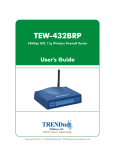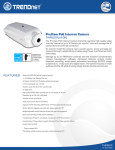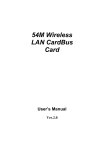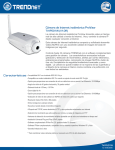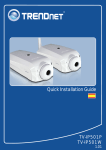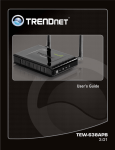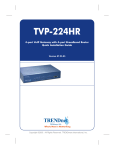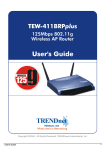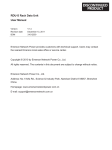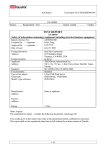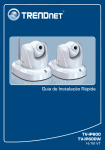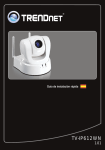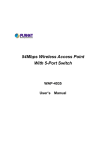Download User Manual
Transcript
TV-IP501W Internet Camera User Manual
USER MANUAL
TV-IP501W
VERSION 1.00
1
TV-IP501W Internet Camera User Manual
Table of Contents
About this User’s Guide ............................................................................................................................4
Before you start ........................................................................................................................................4
Packing List ..............................................................................................................................................4
System Requirements ..............................................................................................................................5
Default Settings ........................................................................................................................................5
Introduction ..............................................................................................................................................6
Features and Benefits .......................................................................................................................6
Camera Hardware Components ...............................................................................................................7
Front Components ............................................................................................................................7
Rear Panel Components...................................................................................................................7
Camera Hardware Components ...............................................................................................................8
LED Indicators ..................................................................................................................................8
Hardware Installation ................................................................................................................................9
Mounting of Camera .........................................................................................................................9
Connect Ethernet Cable..................................................................................................................10
Connect Power Cable .....................................................................................................................10
Reset Camera ................................................................................................................................10
Camera Applications ..............................................................................................................................11
Security ..................................................................................................................................................11
Software - Setup Wizard.........................................................................................................................12
Launching Setup Wizard for the first time .......................................................................................12
Browser Configuration ............................................................................................................................16
Accessing the Camera Video Display .............................................................................................16
Login...............................................................................................................................................17
Web Manager and Live Video Display Page ...................................................................................17
Video – ActiveX ..............................................................................................................................18
Video – Java ...................................................................................................................................18
Administration - Status Section .......................................................................................................20
System Page ..................................................................................................................................20
Video ..............................................................................................................................................20
Audio ..............................................................................................................................................21
Wireless ..........................................................................................................................................21
Network ..........................................................................................................................................21
Active Users ...................................................................................................................................22
Configuration Section .....................................................................................................................23
System ...........................................................................................................................................23
Video ..............................................................................................................................................24
Audio ..............................................................................................................................................24
Wireless ..........................................................................................................................................25
2
TV-IP501W Internet Camera User Manual
Network ..........................................................................................................................................26
User ................................................................................................................................................27
Upload ............................................................................................................................................27
E-Mail .............................................................................................................................................28
Tools Section ..................................................................................................................................28
FTP Server Test .............................................................................................................................29
E-Mail Test .....................................................................................................................................29
Restart ............................................................................................................................................30
Factory Reset .................................................................................................................................30
Firmware Upgrade ..........................................................................................................................30
Backup and Restore .......................................................................................................................31
Software – IPViewPro 2.0 .......................................................................................................................32
Launching IPViewPro 2.0 for the first time ......................................................................................32
Add a camera for monitoring ...........................................................................................................33
Display Controls..............................................................................................................................35
Snapshot, recording and audio controls ..........................................................................................35
Live video display controls ..............................................................................................................36
Camera configuration with IPViewPro .............................................................................................36
Schedule Recording with IPViewPro 2.0 .........................................................................................38
Motion Detection and Digital Input ..................................................................................................39
IPViewPro Miscellaneous Options ..................................................................................................40
Load Saved Video Files ..................................................................................................................41
Technical Specifications .........................................................................................................................43
Limited Warranty ....................................................................................................................................46
3
TV-IP501W Internet Camera User Manual
About this User’s Guide
This user’s guide provides instructions on how to install the TV-IP501W Network Camera and use it for
camera monitoring applications. Camera monitor applications are accessible through an Ethernet local
area network.
Before you start
Please read and make sure you understand all the prerequisites for proper installation of your new
Network Camera. Have all the necessary information and equipment on hand before beginning the
installation.
Packing List
Open the shipping carton and carefully remove all items. In addition to this Manual, ascertain that you
have:
One TV-IP501W Wireless Internet Camera
One Driver & Utility CD-ROM with User’s Guide, IPViewPro 2.0 application and Setup Wizard
One Quick Installation Guide
One Ethernet Cable
One Power Adapter
One Camera Stand
If any of the packaging content is damaged or missing, please contact your dealer immediately. Also keep
the box and packaging materials in case you need to ship the unit in the future.
CAUTION: If powering up the camera with DC power, the Camera must be used with the
power adapter included with the device.
4
TV-IP501W Internet Camera User Manual
System Requirements
Computer
CPU: For Intel x86 compatible CPUs: Intel Pentium IV 2.0Ghz or above
CPU: For IA64 compatible CPUs: AMD Athlon 64 3000+ and above
Memory: 1GB or above
VGA Resolution: 1024 x 768 or above (Independent Display Card recommended)
10BASE-T Ethernet or 100BASE-TX Fast Ethernet Network Interface Card
CD-ROM Drive for Setup Wizard on Installation CD-ROM
IPViewPro 2.0 Application Users must use Microsoft® Windows®2000, XP or Vista Operating
System with Internet Explorer 6.0 or above with DirectX9.0
Network
Local Area Network: 10Base-T Ethernet or 100Base-TX Fast Ethernet
Wireless: 802.11b/g wireless adapter
Note: When you connect multiple cameras and monitor their images synchronously, it is
recommended to use a high performance system, such as a Pentium 4 & 2.4GHz PC
Default Settings
Default configuration settings
Username
This is the Username you will be prompted to enter when you access the
camera configuration screens using a Web browser. The default Username is
admin.
Password
This is the Password you will be prompted to enter when you access the
configuration windows using a Web browser. The default Password is admin.
IP address
This is the IP address you will enter into the Address field of your Web browser
to access the camera monitor screen and configuration menus using a Web
Browser. The camera uses DHCP for IP settings by default. If a DHCP server is
not detected, the default IP address is 192.168.10.30. (Make sure your
computer is configured to belong to the 192.168.10.X subnet if using the default
IP address of the camera.)
Subnet Mask
The default subnet mask is 255.255.255.0
5
TV-IP501W Internet Camera User Manual
Introduction
The TV-IP501W Internet Camera transmits live real-time high-quality Motion-JPEG video through an
Ethernet network useful for remote monitoring applications. The live video can be viewed remotely and
managed through the network from any computer connected to the network.
Features and Benefits
Easy to use - The Camera is a standalone system with built-in CPU, no special hardware or
software is required. The only requirement you need is the web browser software such as Internet
Explorer 6.0 or above. Once you have a valid IP Address, just connect it and you can view the
picture and receive sound from your camera. In addition, the camera’s stand allows you to adjust the
camera for optimal viewing angle.
Live audio for listen and speaking – The built-in mic is useful for listening for voices in front of the
camera.
Supports variety of platforms - The camera supports TCP/IP networking, SMTP e-mail, JAVA,
HTTP and other Internet related protocols. It can be utilized in a mixed operating system
environment, including Windows 2000/XP/Vista, Linux and Mac OS. Moreover, it can be integrated
easily into other www/ Intranet applications.
Web configuration - Applying a standard web browser, the administrator can configure and manage
the camera directly from its own web page via the Intranet or Internet.
Remote Utility - The powerful IPViewPro 2.0 application assigns the administrator with a
pre-defined user ID and password, allowing the administrator to modify the camera settings from the
remote site via Intranet or Internet. When new firmware is available, you can also upgrade remotely
over the network for added convenience. Users are also allowed to monitor the image, and take
snapshots.
6
TV-IP501W Internet Camera User Manual
Camera Hardware Components
Front Components
Rear Panel Components
7
TV-IP501W Internet Camera User Manual
Camera Hardware Components
Below is a summary description of the camera hardware.
Audio Mic
Used to capture sounds
DC 5V
The DC power input connector is located on the back of the camera’s rear panel and
is labeled DC5V with a single jack socket to supply power to the camera. Power will
be generated when the power supply is connected to a wall outlet.
Reset
The Reset procedure will be initiated when this button is pressed. The Factory
Reset procedure will be initiated when this button is pressed and hold for five
seconds.
10/100 Ethernet
This RJ-45 connector is used to connect to a 10Base-T Ethernet or to a
LAN Port
100Base-TX Fast Ethernet network. This port supports the N-Way protocol &
Auto-MDIX, allowing the camera to automatically detect or negotiate the
transmission speed of the network.
Camera Stand
It’s located on the top and the bottom panel of the camera. This hole is used to
Connector
connect the camera’s stand to the camera by attaching the screw head of the
camera stand into the screw hole of the camera.
LED Indicators
PWR
This LED indicator lights blue when the camera is powered on. It remains dark when
powered off.
LNK
A steady orange light indicates that the camera has a good connection to
LAN/WLAN. It starts flashing to indicate that the camera is sending and receiving
data to and from the LAN.
8
TV-IP501W Internet Camera User Manual
Hardware Installation
The camera can be attached to the included stand and placed on a sturdy flat surface or hung from a
ceiling or similar flat surface.
Mounting of Camera
Determine the location for the camera and assemble the camera stand. Secure the stand to the flat
surface or ceiling with the mounting screws included in the package. When the stand is assembled and
firmly attached to flat surface or ceiling, attach the camera. Do not attach network cables or the power
cord until the camera is firmly mounted in place.
9
TV-IP501W Internet Camera User Manual
Connect Ethernet Cable
To connect the camera to your network, connect a Category 5 or better Ethernet cable to the network
cable connector located on the camera’s rear panel, and then attach it to the network. The Ethernet port
will automatically detect and adjust to the speed (10 or 100 Mbps) and polarity (MDI-II or MDI-X) of the
connection.
Connect Power Cable
To provide power to the camera using the AC Adapter, connect the AC power adapter to the DC power
input connector, also located on the camera’s left side panel, and then plug it to the electrical outlet. As
with any electrical device, make sure the power source and camera are located in an area where it is not
going to get wet or present an electrical hazard.
Reset Camera
A manual reset can be conducted by following the procedure below. The reset button is located on the
rear panel of the camera. To reset the system settings to factory defaults, please follow these steps:
1.
Leave the camera powered on, do not disconnect the power.
2.
Use a paper clip or similar object to press the reset button and hold. See the Rear Panel picture
above to locate the reset button.
3.
Keep the button pressed about 5 seconds.
4.
Release the button.
The camera will then automatically reboot itself. Upon restarting the camera loads the factory default
configuration settings. The default IP address 192.168.10.30 and subnet mask 255.255.255.0 will be
applied unless a DHCP server is actively connected to the network. The administrator’s default user
name is admin and the password is admin. Use the Setup Wizard shipped with the camera to reconfigure
it or access it through the web based management software.
10
TV-IP501W Internet Camera User Manual
Camera Applications
The camera can be applied in wide variety of applications. With the built-in CPU, it can work as a
standalone system that provides a web-based solution transmitting high quality video images and sounds
for monitoring purposes. It can be managed remotely, accessed and controlled from any PC desktop over
the Intranet or Internet via a web browser. With the easy installation procedure, real-time live images will
be available.
Applications:
Monitoring of local and remote places and objects such as construction sites, hospitals, amusement
parks, schools and day-care centers using a web browser.
View image from IPViewPro.
Configure the camera to save image or send-mail messages with a short video file
Security
To ensure the highest security and prevent unauthorized usage of the camera, the administrator has the
exclusive privilege to access the System Administration for settings and control requirements to allow
users the level of entry and authorize the privileges for all users. The camera supports multi-level
password protection. Access to the camera is strictly restricted to define the user who has a “User Name”
and “User Password” that is assigned by the administrator. The administrator can release a public user
name and password to allow remote users to access the camera.
11
TV-IP501W Internet Camera User Manual
Software - Setup Wizard
This section describes the how to setup a camera using the Setup Wizard. To install the Setup Wizard on
a system running Windows, launch the Setup Wizard on the installation CD-ROM and follow the setup
instructions. Once the software is installed, the Setup Wizard utility is ready for use.
Launching Setup Wizard for the first time
To launch the Setup Wizard, click Start > Programs > TRENDnet > Setup Wizard > Setup Wizard
Install Your Camera
Connect the camera to your LAN using
the provided RJ45 cable.
Connect the AC Power Adapter to the
back of the camera and to a live power
socket.
Click Next to continue.
Select Your Camera
The following screen appears showing the
cameras that have been found on your
network.
Click on the camera you want to configure.
Click Next to continue
Authentication
On the following screen type in the ID and
Password that you will use to configuring the
camera settings.
Type a User ID in the ID field.
Type the password of the User in the
Password field.
Click Next to continue
12
TV-IP501W Internet Camera User Manual
Change Password
The following screen allows you to change the
default admin password.
Carry out the following if you want to change
the admin password:
Tick the Change Password checkbox
Type in a New Password in the New
Password field and confirm it in the
Confirm Password field
Click the Next button to proceed to the
next Setup window
If you don’t want to change the admin
password, leave the checkbox un-ticked
and click Next
Select a Connection Option
The following window allows you to specify the
connection method used by your camera
network.
Click the radio button of the network
environment your camera is connected to. The
available options are:
PPPoE
DHCP
Fixed IP
If your connection method is DHCP, click the
DHCP radio button and click Next.
Select a Connection Option- PPPoE
If your connection method is PPPoE, click the
PPPoE radio button and click Next. The
following window appears.
Type the User Name used to connect to
your PPPoE connection in the User Name
field.
Type the Password of the PPPoE User
Name in the Password field and confirm it
in the Confirm Password field.
Click Next to proceed to the next setup
window
13
TV-IP501W Internet Camera User Manual
Select a Connection Option- Fixed IP
If your connection method is Fixed IP, click the
Fixed IP radio button. The following window
appears.
Type in the IP Address, Subnet Mask,
Default Gateway, Primary DNS Server IP
address and Secondary DNS Server IP
Address in the appropriate fields.
Click Next to proceed to the next setup
window.
Setup Wireless.
Here you can choose to use wireless for this
camera or not.
Manually Setup Wireless.
Here you can choose one of the existing
wireless networks in the Available AP option
or you can setup the wireless connection
manually.
Enter the appropriate SSID, Wireless Mode,
Channel, Authentication, Encryption and Key.
Other Settings
The following window allows you to configure
additional camera settings.
Type a name to help you identify the
camera in the Camera Name field.
Set the camera date and time from the
Camera Time drop-down menus. To use
the time settings from your computer, click
the Copy Local Time button.
Click Next when you have finished
14
TV-IP501W Internet Camera User Manual
configuring the other settings.
Setting Up The Camera
The following window appears, summarizing
the network settings of your camera.
When you have finished setting up the
Camera click the Next button. To make
any changes to your Camera settings,
click the Previous button.
Camera Restart
The following window appears, indicating that
the camera is restarting.
Complete
After the camera has restarted, the following
window will appear.
Click the hyper-link to connect to the
camera web interface.
If you want to setup an additional camera,
click the Setup Another Camera button.
When you have finished, click the Exit
button to close the Setup Wizard.
15
TV-IP501W Internet Camera User Manual
Browser Configuration
The camera is easy to use and manage using a web browser or the IPViewPro 2.0 software to access the
camera’s live video display, and configuration software. Check and make sure the computer can access
and use the camera before placing it in the location where it will be used, especially if it is mounted to a
ceiling or other difficult to access area.
For the initial setup, use the Setup Wizard program located on the CD-ROM included with the camera.
Use the Setup Wizard to assign an IP address and other network settings. Once the camera has an IP
address, follow the instructions below to access the camera’s web management interface used to
manage the camera and for video display.
Accessing the Camera Video Display
If the camera is used on a network with an active DHCP server, the camera will detect it and obtain an IP
address. If you are using the camera on a network with a DHCP server it is necessary to first determine
what the IP address of camera is. To do this, follow the instructions in the Quick Installation Guide to
launch the Setup Wizard software utility used with the network camera.
NOTE: If your network uses DHCP or has an active DHCP server running, use the Setup
Wizard utility on the installation CD-ROM shipped with the camera to first access the
camera. Once it is accessed, you can change the IP address or continue to use the DHCP
assigned address as preferred.
If your network does not use a DHCP server, the camera will use a default IP address of 192.168.10.30.
Use this address to access the web-based management software. Use a web browser and type in http://
followed by the default IP address, 192.168.10.30 in the address bar of the browser and press the Enter
key. The URL in the address bar should read: http://192.168.10.30
If the login dialog does not appear, check the proxy server settings on your browser.
NOTE: The wrong proxy server settings on your browser can prevent connection to the web
manager. If you are having trouble connecting to the camera, configure the proxy settings to
bypass the proxy server or disable use of proxy servers and try to connect again
16
TV-IP501W Internet Camera User Manual
Login
To access the web manager directly from a computer or on a network without a DHCP server running,
use the default IP address of the camera in the browser address entry to access the web manager. Type
http://192.168.10.30 in the address bar and press Enter. The login dialog appears when accessing the
camera.
Type the default user name “admin”, default password “admin” and click on the OK button to access the
camera’s management interface.
Web Manager and Live Video Display Page
After login you’ll be directed to the Home page which will display the last video screenshot.
The camera’s web configuration provides two methods of viewing live video display:
View Video - ActiveX page
View Video - Java page
17
TV-IP501W Internet Camera User Manual
Video – ActiveX
To view live video from
browser, using ActiveX, click
the View Video-ActiveX Mode
from the Welcome screen to
access the live video feed :
Video – Java
To view live video from
browser, using JAVA, click
the View Video-JAVA Mode
from Welcome screen to
access the live video feed:
As you can see, both live video display pages are identical both in look and the controls that are available
to manage the display.
18
TV-IP501W Internet Camera User Manual
Video Display Control
The Zoom option allows you to digitally zoom in on an object up to 4
times
The Audio option allows you to toggle Audio mode ON or OFF
The E-mail Image option allows you to turn the image e-mailing option
ON or OFF
The Upload Image option allows you to turn the image uploading
option ON or OFF
19
TV-IP501W Internet Camera User Manual
Administration - Status Section
The Status section displays information about the camera. In the Status section there are pages for
System, Video, Audio, Network and Active Users.
System Page
The System Page display information about the Device Status and Ethernet Status of the camera.
Information like the Camera Name, Location, Product Code, Firmware Version, MAC address, IP address,
Link Status, Link Speed and Duplex.
Video
The Video page displays information about the video configuration of the camera like Video Resolution
Compression Rate, Frame Rate Frame Size and Light Frequency.
20
TV-IP501W Internet Camera User Manual
Audio
The Video page displays information about the audio configuration of the camera like Audio Enabled or
Disabled, Audio Volume Level, Codec and Sample rate.
Wireless
The Wireless page displays information about the wireless configuration of the camera.
Network
The Network page display the network configuration for the camera like IP Address, Subnet Mask,
Default gateway, Primary and Secondary DNS Addresses, Dynamic DNS Enabled or Disabled,
Secondary HTTP Port value, UPnP IP Address, FTP Server and E-Mail setup.
21
TV-IP501W Internet Camera User Manual
Active Users
The Active Users Page displays information about the current active users that are connected to the
camera like IP Address, Name, Date/Time and Speed/Throughput.
22
TV-IP501W Internet Camera User Manual
Configuration Section
In the configuration you can set the configuration for the camera.
System
On the Status Page you can configure general system settings for the camera.
Camera Name:
Configure the camera’s display name.
Location:
Configure the camera’s display location.
Admin:
Configure the Username and Password for
the camera.
LED Control:
Configure the LED display Controls. ON /
OFF / DUMMY
23
TV-IP501W Internet Camera User Manual
Video
On the Video page you can configure the video display settings for the camera.
Video Resolution:
Select between 3 different Video Resolutions.
Compression Rate:
Select between 5 different Compression Rates.
Frame Rate:
Select between 5 different Frame Rates
Choose Auto to let the camera choose the best
frame rate needed.
Brightness Control:
Option to manually configure the video brightness.
Contrast Control:
Option to manually configure the video contrast.
Saturation Control:
Option to manually configure the video saturation.
Light Frequency:
Option to configure the light frequency.
Mirror:
Option to flip the live video feed horizontal or vertical.
Anti-Flicker:
Option to enable or disable Anti-Flicker.
Audio
On the Audio page you can configure the audio settings for the camera.
Audio:
Option to enable or disable the Audio settings.
Volume:
Option to set the Volume level.
24
TV-IP501W Internet Camera User Manual
Wireless
On the Wireless page you can setup the wireless configuration for this camera.
Configuration Mode:
Choose the appropriate wireless configuration
mode for this camera. Infrastructure is used if this
camera will connect to an existing wireless
network. Ad-Hoc is used if this camera will connect
directly to a computer wireless.
SSID:
Here enter the SSID for the wireless network.
Wireless Channel:
Here select the correct channel for the wireless.
Alternatively you can click Site Survey which will
scan for an existing wireless network and enter the
above mentioned values automatically.
Transmission Rate:
Here you can choose the transmission rate
required.
Encryption Type:
Here you can setup the wireless security required
for this camera to connect to the wireless network.
You can choose one of 3 options, Disabled, WEP
and WPA/WPA2.
Beacon Interval:
Here you can enter the Beacon Interval used for
the wireless network.
Preamble:
Here you can choose the preamble used for your wireless network. Long or Short.
25
TV-IP501W Internet Camera User Manual
Network
Click the Network Setup link to view menus for IP network settings, PPPoE configuration, DDNS and
HTTP port configuration.
Fixed IP:
Selecting Static IP Configuration requires you to
assign IP information for the camera manually.
Dynamic IP (DHCP):
Selecting DHCP Configuration will cause the
camera to obtain an IP address from a local DHCP
Server.
PPPoE:
Enable this feature if you want the camera to
access the Internet using PPPoE. This requires
and PPPoE Username and Password.
DNS IP Address:
Enter DNS IP Addresses used by your ISP here
manually.
Enable DDNS:
Enable this feature to use Dynamic DNS. This requires a DDNS account and you must enter the details
accordingly here.
Second HTTP Port:
You can enable or disable a secondary http port here. You can change the port number used for the
secondary http connection.
UPnP:
Enable this feature to be able to connect to this camera using UPnP
26
TV-IP501W Internet Camera User Manual
User
On the User page you can create or delete users.
Access Control:
Here you can enable or disable user access
control.
Define User:
Here you can add user accounts.
Delete User:
Here you can remove user accounts.
Upload
On this page you can define how the camera uploads images to an FTP server.
Host Address:
Enter the FTP Server’s IP Address here.
Port number:
Enter the FTP port used here.
Username:
Enter the FTP Username here.
Password:
Enter the FTP Password here.
Directory Path:
Enter the FTP Directory Path here.
Passive Mode:
Enable or Disable Passive Mode here.
Time Schedule:
You can setup the time schedule here.
Manual Operation:
Setup Manual Operation here.
27
TV-IP501W Internet Camera User Manual
E-Mail
On this page you can setup the e-mail client configuration that the camera can use.
SMTP Server Address:
Enter the Mail Server IP address here.
SMTP Port Number:
Enter the SMTP port number used here.
Sender’s E-Mail Address:
Enter the Sender’s e-mail address here:
Recipient’s E-Mail Address:
Enter the Recipient’s e-mail address here.
User Name:
Enter the mail client username used here.
Password:
Enter the mail client password used here.
Time Schedule:
You can define the time schedule here.
Manual Operation:
You can setup manual operation here.
Tools Section
The Tools section offers many features to test FTP server settings E-Mail settings Firmware upgrade,
Backup settings and Restart or Restore options.
28
TV-IP501W Internet Camera User Manual
FTP Server Test
This page will help the user to test if the FTP server settings are setup correctly. It will send a JPEG file to
the FTP server called ‘test_date_time.jpg’ as a test.
E-Mail Test
This page will help the user to test if the e-mail settings are setup correctly. It will send a test mail to the
recipient’s e-mail address as a test.
29
TV-IP501W Internet Camera User Manual
Restart
This page gives you the option to manually restart the camera.
Factory Reset
This page gives you the option the factory reset your camera through its web configuration.
Firmware Upgrade
This page gives you the option to upgrade the firmware for the camera. To upgrade the firmware you’ll
need to download the latest firmware for your camera to your computer, click on the Browse button,
navigate to the downloaded file and click Upgrade. This will upgrade the firmware for your camera.
30
TV-IP501W Internet Camera User Manual
Backup and Restore
This page will allow the user to backup the configuration of the camera to a file that can be saved
remotely. It also gives the option to restore the settings from the backup file saved on the hard drive.
31
TV-IP501W Internet Camera User Manual
Software – IPViewPro 2.0
This section describes the how to setup a camera using the IPViewPro 2.0 camera monitoring software.
To install IPViewPro 2.0 on a system running Windows, launch the IPViewPro 2.0 installation software on
the installation CD-ROM and follow the setup instructions. Once the software is installed, the IPViewPro
2.0 camera monitoring utility is ready for use. Add up to 32 network cameras to monitor using the software.
Additional software, IPViewPro Player software is also installed. The IPViewPro Player is used for playing
recorded video from cameras that have been configured to save recorded files.
Launching IPViewPro 2.0 for the first time
To launch IPViewPro 2.0, click Start > Programs > Network Surveillance > IPViewPro 2.0. If this is the first
time using the software, the menu that appears on is the Add camera menu.
32
TV-IP501W Internet Camera User Manual
Add a camera for monitoring
The Add camera menu is presented the first time the IPViewPro 2.0 software is launched. This menu is
used to add cameras to the user interface for monitoring. After the first time running the software, this
menu can be accessed at anytime from the configuration menus. The configuration menus are described
in a later section of this chapter. Notice that the IPViewPro 2.0 software has automatically detected
eligible cameras running on the network.
To add a camera to the IPViewPro 2.0 user interface, follow these instructions:
1.
Check the list of cameras detected by the
software, if the camera you want does not
appear on the list then clicks the Refresh
button to conduct another search. If it still
does not appear, check the IP address of the
camera and click on the Input the location of
camera menu tab and skip ahead to step 2.1
2.
Select the camera to add from the list, enter
the administrator’s user name (ID :) and
password, a preview of the live video display
will appear. Click the OK, add this camera
button, a confirmation message informs
when the camera is connected and added to
the IPViewPro monitoring group. Repeat this
procedure for all the cameras being added.
Click the Exit button after all the cameras
have been added.
If the camera does not appear listed, click the Input the location of camera tab above the list to view a
new menu. Enter the IP address or the URL (for example, ipcam.ddns.org) of the camera being added,
type the user name and password and click the Preview to verify that a link can be established. The live
video of the camera should appear in the Live preview display. If a link cannot be established, run the
Setup Wizard software for the camera and verify the correct IP address.
3. Once the cameras have been added, they are ready to be used in the main IPViewPro user interface.
Close the Add camera menu (click Exit) to go to the main user interface. See below for a description.
33
TV-IP501W Internet Camera User Manual
IPViewPro 2.0 User Interface
No.
Item
Description
1
Live video display area
Display area for single or multiple cameras of live video.
Right click on any display area to view a list of quick
configure options for that camera including the “Replace
camera content …” option used to change the order of the
live video displays for multiple camera views.
2
Minimize and Exit
Use to minimize IPViewPro interface or exit the program, a
confirmation is required to exit.
3
4
Pan and Tilt control
Click directional arrows to move camera in that direction
(Only for cameras equipped with
within the limits of the pan and tilt range. The + in the center
RS-485 controlled pan/tilt
of the control is used to return to the home or center view as
motorized mount)
configured for the camera.
Snapshot, recording and audio
See below for detailed information.
controls
5
Live video display controls
See below for detailed information.
6
Camera configuration menu
See below for detailed information.
7
Camera status
Use to quickly assess the status of operating cameras. Click
on box to select camera display. The status indicators for
each camera display recording, motion detection and GP
input status.
8
Camera information
Displays basic information on selected camera.
34
TV-IP501W Internet Camera User Manual
Display Controls
The primary display and IPViewPro control icons are described in detail below. When there are more than
one camera displays viewed, one of the displays can be selected for management or additional changes.
Simply left click on any display to select it. Notice the border around the display is bright aqua blue,
indicating the “selected” status. For example, to go to a single screen display for any one camera, select
the camera and click on the single screen display.
Left click on any display to “select” that display for
camera management. Right click to view camera
management and display options.
Snapshot, recording and audio controls
The still photo camera icon is used to take a snapshot of the selected live video display. The video
camera icon is used to begin video recording of the selected live video display. Snapshot and videos files
are stored in a default folder on the administrator’s system, or in a folder designated by the administrator.
The audio controls are represented by a microphone icon to activate the internal mic or the auxiliary audio
input (if present), and a speaker icon for the audio output (remote speakers, if present).
Notice that when these functions are activated, the color of the icon changes from white to yellow.
Inactive
Active
35
TV-IP501W Internet Camera User Manual
Live video display controls
Use the video display controls to change the view of the live video display. This is useful for multiple
camera application.
Camera configuration with IPViewPro
Access the camera configuration menus by clicking on the gear icon at the bottom of the right hand panel
of the IPViewPro user interface. Configuration options include adding and deleting cameras from the
display view, configuration of motion detection and digital input with schedules, recording options, email
alerts and other network settings.
Adding a Camera
The procedure to add a camera after the initial launch of the software is very similar to the procedure
used during the first setup. Follow the instructions below to add cameras.
1.
Click the Configuration icon to view the
Camera Setup menu. The top most tab of
the menu is the Camera Management tab. A
list of active cameras appears on the left half
of the menu. Select the camera to be added
from the list. Click the Add Camera by IP
Address to find the specified IP address or
network URL of the camera you want to add.
36
TV-IP501W Internet Camera User Manual
2.
Select the camera to add from the list, enter
the administrator’s user name (ID :) and
password, a preview of the live video display
will appear. Click the OK, add this camera
button, a confirmation message informs
when the camera is connected and added to
the IPViewPro 3.0 monitoring group. Repeat
this procedure for all the cameras being
added. Click the Exit button after all the
cameras have been added.
3.
The camera added now appears in the
Camera List. To launch the web manager for
the newly added camera or any camera in
the active camera list, select it and click the
Browse Selected Camera button.
Removing a Camera
To remove the camera from the list of active:
1.
Select the camera you want to remove.
2.
Click Delete Selected Camera.
Note: Any camera display can be removed from the main IPViewPro 2.0 user interface by right clicking on
the display screen for the camera and selecting the Remove this Camera option.
Launch Web Manager for Selected Camera
To launch the web-based IP Camera manager for any active camera in the list, simply select it and click
the Browse Selected Camera button.
37
TV-IP501W Internet Camera User Manual
Schedule Recording with IPViewPro 2.0
Use the Camera Setup menu to create schedules for recording and apply the schedules to any camera.
Click the Camera Settings tab to view the Schedule Recording menu (the first menu viewed in the
Camera Settings menu tab).
To apply an existing schedule template, click the
Select button and choose a schedule from the list
of previously created schedule templates. If a new
schedule is needed it can be created from the
Select Schedule Template menu (See below).
Create Schedule Templates
To make a new schedule template, click the Create
Template button to view the Create Schedule
Profile menu. Use this menu to create new
schedules for recording.
38
TV-IP501W Internet Camera User Manual
Motion Detection and Digital Input
The Camera Settings menus include Motion Detection setup and Digital Input control. Each menu has the
schedule option to apply a schedule for the action taken or always take the specified action.
For Motion Detection, use the Config motion detection area menu to create the area to which it is
applicable. Click the Config motion detection area button in the Motion Detection setup menu to view the
menu in a new pop up window.
39
TV-IP501W Internet Camera User Manual
IPViewPro Miscellaneous Options
The Other Options available for configuration include Proxy server setup, email notification, scan interval
and alert type settings.
40
TV-IP501W Internet Camera User Manual
Load Saved Video Files
Each camera has a file created automatically for storing video files. These files are normally located in the
My Documents folder in Windows. The file folders are named according to the IP address and camera
model. For example, 192.168.10.30_TV-IP501W is the name of the file folder for the TV-IP501W using
the default (non-DHCP) IP address.
No.
Item
Description
1
File list
Video files added to the list are viewed in the order listed.
2
View Screen
Video files in the list are played here. The progress bar and starting time
of the video clip appears beneath the view screen.
3
Add/Delete files
Use the Search Files button to add recorded video files. A new menu
from list
pops up that is used to find and add files to the list. (See description on
next page)
4
Playback controls
Standard video playback controls for Stop, Play/Pause, go to next file
(>>) or go to previous file (<<) Speed up and Speed down to control
speed of playback. The vertical slider control is used for audio volume
control.
To view recorded video files in the IPViewPro Player, it is first necessary to locate and select the files to
be viewed and add them to the list. Click the Search Files button in the IPViewPro Player main interface
and a new menu appears.
In the new menu, use the Select Camera pull-down menu to choose the video file folder of the camera to
be reviewed. Use the Search Time menu to narrow the search to a specific time and date. Finally, the
Event selection menu is used to further narrow the scope of the file search for videos triggered by Motion
41
TV-IP501W Internet Camera User Manual
Detection or a Digital Input device, or files designated for Server Recording. When the search criteria
have been defined, click the Search button to place qualified files in the Search list.
Choose the files to be added to the view file list by check marking the individual files or click the Select All
button to check mark all files in the Search list, click Add to place the check marked files on the list of files
for viewing.
After the files to be viewed have been chosen, click the OK button.
42
TV-IP501W Internet Camera User Manual
Technical Specifications
Camera
General
Sensor: 1/4” color CMOS image sensor
Resolution: up to 640 x 480 pixels
Board lens
Focal length: 4.57mm
F/No: F1.9
Minimum illumination: 1 Lux
Focus depth: 20cm ~ infinity
View angle: horizontal: 45 degree, vertical: 35 degree
Audio
Built-in microphone
Sensitivity: -48dB +/- 3dB (5 meters max)
Frequency: 50~16000Hz
S/N: 50dB
Codec: PCM
Image & Video
Compression: MJPEG
Exposure/white balance control: automatic
Resolution: VGA (640x480), QVGA (320x240), QQVGA (160x120) up to
30fps
Hardware
Network
IEEE 802.3u 10/100Mbps Fast Ethernet, Auto-MDIX
LED
Power, Link
Reset Button
Reset settings
Power
2.6 watts
Consumption
Power
5V, 2.5A external power adapter
Stand Dimension
128 mm (4.7 in.)
Temperature
Operating: 5°C ~ 40°C (41°F ~ 104°F)
Storage: -25°C ~ 50°C (5°F ~ 122°F)
Certification
CE, FCC
43
TV-IP501W Internet Camera User Manual
Wireless
Standard
IEEE 802.11b and IEEE 802.11g
Frequency
2.412 ~ 2.4835GHz ISM band
Antenna
1 x 2dBi detachable dipole antennas (Reverse-SMA connector)
Data Rate
802.11b: 11Mbps, 5.5Mbps, 2Mbps and 1Mbps
(auto fallback)
802.11g: 54Mbps, 48Mbps, 36Mbps, 24Mbps, 18Mbps, 12Mbps, 9Mbps
and 6Mbps
Security
64/128-bit WEP(ASCII/HEX), WPA-PSK, WPA2-PSK
Output Power
802.11b: 16dBm (typical)
802.11g: 12dBm (typical)
Receiving
802.11b: -82dBm at 11Mbps
Sensitivity
802.11g: -66dBm at 54Mbps
Channel
1~11 (FCC), 1~13 (ETSI)
Requirement
To View Camera
Internet Explorer 6.0 or above, Safari 2.0 or above, Firefox 2.0 or above
Browser
and Netscape
To Run IPView Pro Windows XP (32/64-bit), Vista (32/64-bit)
Software
IPView Pro 2.0
Channel: supports up to 32 cameras
Record/Playback/Motion Detection/Audio
Network Protocols
IPV4, ARP, TCP, UDP,ICMP
DHCP Client, NTP Client, DNS Client, DDNS Client, SMTP Client, FTP
Client
HTTP Server
PPPoE
UPnP
Management
Remote
Remote management supported
Backup / Restore
Save/retrieve configuration files
44
TV-IP501W Internet Camera User Manual
Settings
Image
Brightness, contrast, noise reduction, saturation, sharpness, white balance,
flip mirror(horizontal/vertical)
Video
Encoding type: MJPEG
Compression rate: 5 levels
Frame rate: 1, 5, 7, 15, 20, Auto (up to 30fps)
Frequency: 50Hz, 60Hz
Recording
Storage size: 32MB (minimum)
(via Software)
Recording type: event based (motion detection), continuous and scheduled
Snapshot
Trigger event: motion detection
(via Software)
Action: send alert email and/or upload to FTP
Access Port
HTTP port: 80 (default)
Digital Zoom
4x
Dynamic DNS
Yes
Time
Synchronize with NTP server or set time/date manually
45
TV-IP501W Internet Camera User Manual
Limited Warranty
TRENDware warrants its products against defects in material and workmanship, under normal use and service, for the following
lengths of time from the date of purchase.
TV-IP501W – 3 Years Warranty
AC/DC Power Adapter, Cooling Fan, and Power Supply carry 1 year warranty.
If a product does not operate as warranted above during the applicable warranty period, TRENDware shall, at its option and
expense, repair the defective product or part, deliver to customer an equivalent product or part to replace the defective item, or
refund to customer the purchase price paid for the defective product. All products that are replaced will become the property of
TRENDware. Replacement products may be new or reconditioned.
TRENDware shall not be responsible for any software, firmware, information, or memory data of customer contained in, stored on,
or integrated with any products returned to TRENDware pursuant to any warranty.
There are no user serviceable parts inside the product. Do not remove or attempt to service the product by any unauthorized
service center. This warranty is voided if (i) the product has been modified or repaired by any unauthorized service center, (ii) the
product was subject to accident, abuse, or improper use (iii) the product was subject to conditions more severe than those
specified in the manual.
Warranty service may be obtained by contacting TRENDware office within the applicable warranty period for a Return Material
Authorization (RMA) number, accompanied by a copy of the dated proof of the purchase. Products returned to TRENDware must
be pre-authorized by TRENDware with RMA number marked on the outside of the package, and sent prepaid, insured and
packaged appropriately for safe shipment.
WARRANTIES EXCLUSIVE: IF THE TRENDWARE PRODUCT DOES NOT OPERATE AS WARRANTED ABOVE, THE
CUSTOMER’S SOLE REMEDY SHALL BE, AT TRENDWARE’S OPTION, REPAIR OR REPLACEMENT. THE FOREGOING
WARRANTIES AND REMEDIES ARE EXCLUSIVE AND ARE IN LIEU OF ALL OTHER WARRANTIES, EXPRESSED OR
IMPLIED, EITHER IN FACT OR BY OPERATION OF LAW, STATUTORY OR OTHERWISE, INCLUDING WARRANTIES OF
MERCHANTABILITY AND FITNESS FOR A PARTICULAR PURPOSE. TRENDWARE NEITHER ASSUMES NOR
AUTHORIZES ANY OTHER PERSON TO ASSUME FOR IT ANY OTHER LIABILITY IN CONNECTION WITH THE SALE,
INSTALLATION MAINTENANCE OR USE OF TRENDWARE’S PRODUCTS.
TRENDWARE SHALL NOT BE LIABLE UNDER THIS WARRANTY IF ITS TESTING AND EXAMINATION DISCLOSE THAT
THE ALLEGED DEFECT IN THE PRODUCT DOES NOT EXIST OR WAS CAUSED BY CUSTOMER’S OR ANY THIRD
PERSON’S MISUSE, NEGLECT, IMPROPER INSTALLATION OR TESTING, UNAUTHORIZED ATTEMPTS TO REPAIR OR
MODIFY, OR ANY OTHER CAUSE BEYOND THE RANGE OF THE INTENDED USE, OR BY ACCIDENT, FIRE, LIGHTNING,
OR OTHER HAZARD.
46
TV-IP501W Internet Camera User Manual
LIMITATION OF LIABILITY: TO THE FULL EXTENT ALLOWED BY LAW TRENDWARE ALSO EXCLUDES FOR ITSELF AND
ITS SUPPLIERS ANY LIABILITY, WHETHER BASED IN CONTRACT OR TORT (INCLUDING NEGLIGENCE), FOR
INCIDENTAL, CONSEQUENTIAL, INDIRECT, SPECIAL, OR PUNITIVE DAMAGES OF ANY KIND, OR FOR LOSS OF
REVENUE OR PROFITS, LOSS OF BUSINESS, LOSS OF INFORMATION OR DATE, OR OTHER FINANCIAL LOSS ARISING
OUT OF OR IN CONNECTION WITH THE SALE, INSTALLATION, MAINTENANCE, USE, PERFORMANCE, FAILURE, OR
INTERRUPTION OF
THE POSSIBILITY OF SUCH DAMAGES, AND LIMITS ITS LIABILITY TO REPAIR, REPLACEMENT, OR REFUND OF THE
PURCHASE PRICE PAID, AT TRENDWARE’S OPTION. THIS DISCLAIMER OF LIABILITY FOR DAMAGES WILL NOT BE
AFFECTED IF ANY REMEDY PROVIDED HEREIN SHALL FAIL OF ITS ESSENTIAL PURPOSE.
Governing Law: This Limited Warranty shall be governed by the laws of the state of California.
Some TRENDnet products include software code written by third party developers. These codes are
subject to the GNU General Public License ("GPL") or GNU Lesser General Public License ("LGPL").
Go to http://www.trendnet.com/gpl or http://www.trendnet.com Download section and look for the
desired TRENDnet product to access to the GPL Code or LGPL Code. These codes are distributed
WITHOUT WARRANTY and are subject to the copyrights of the developers. TRENDnet does not provide
technical support for these codes. Please go to http://www.gnu.org/licenses/gpl.txt
or http://www.gnu.org/licenses/lgpl.txt for specific terms of each license.
47
TV-IP501W Internet Camera User Manual
Federal Communication Commission Interference Statement:
This equipment has been tested and found to comply with the limits for a Class B digital device,
pursuant to Part 15 of the FCC Rules. These limits are designed to provide reasonable protection against
harmful interference in a residential installation. This equipment generates uses and can radiate radio
frequency energy and, if not installed and used in accordance with the instructions, may cause harmful
interference to radio communications. However, there is no guarantee that interference will not occur
in a particular installation. If this equipment does cause harmful interference to radio or television
reception, which can be determined by turning the equipment off and on, the user is encouraged to try
to correct the interference by one of the following measures:
Reorient or relocate the receiving antenna.
Increase the separation between the equipment and receiver.
Connect the equipment into an outlet on a circuit different from that to which the receiver is
connected.
Consult the dealer or an experienced radio/TV technician for help.
This device complies with Part 15 of the FCC Rules. Operation is subject to the following two conditions:
(1) This device may not cause harmful interference, and
(2) This device must accept any interference received, including interference that may cause undesired
operation.
FCC Caution:
Any changes or modifications not expressly approved by the party responsible for compliance could void
the user's authority to operate this equipment.
IEEE 802.11b or 802.11g operation of this product in the U.S.A. is firmware-limited to channels 1
through 11.
IMPORTANT NOTE:
FCC Radiation Exposure Statement:
This equipment complies with FCC radiation exposure limits set forth for an uncontrolled environment.
This equipment should be installed and operated with minimum distance 20cm between the radiator &
your body. This transmitter must not be co-located or operating in conjunction with any other antenna
or transmitter.
48
TV-IP501W Internet Camera User Manual
49

















































